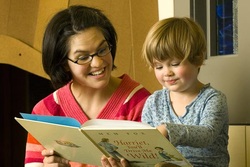
1. Focus on the letters of her name. Names are the most important words for children, so it makes sense to begin literacy learning with the child’s name. Acknowledge the “child’s letter”—the first letter of his or her name—by pointing it out whenever and wherever you see it. Then do some letter scrambles using blocks, magnetic letters or letters on index cards. Mix up the letters of the child’s name and work together to put them back in the proper order. Repeat this often with your child’s name, and then introduce “Mom,” “Dad,” and the names of siblings, friends, family and pets.
2. Recognize each letter and know their sounds. It’s one thing for the child to know the letters in order, but it’s a bit harder for her to recognize each letter individually. When you see “her letter” on a sign, cereal box, or book, remember to point it out. Say, “Hey! Look here! I found your letter, Maddy! Here’s an M for Maddy. Mmmm, mmmm, Maddy!”
Talk about the sounds that letters make and return frequently to easily relatable objects or things that interest the child. For example, say: “There’s a letter B for ‘blankie.’ I know you love blankie and sleep with it every night. Blankie begins with the letter B, like ‘ball’ and ‘butter’ and ‘baby bear.’ What else can you think of that begins with the B sound?”
3. Introduce uppercase and lowercase letters. Your child will not likely be reading books that have all uppercase letters, so it’s imperative that you talk about uppercase and lowercase letters early on. Play games that involve matching uppercase and lowercase letters and spell her name using both cases.
4. Practice early writing techniques. If children practice creating several simple letters, they will most likely be able to write the majority of the alphabet. Begin with X and O and then move on to a square and a triangle. Encouraging kids to “write” on sand, paint with water, or use their finger in shaving cream will make creating these shapes fun, and before you know it, they’ll be ready to move on to the letters of their names.
5. Connect objects with words. Because reading involves creating meaning by combining words, pictures and prior knowledge, early readers lean on illustrations when reading—and that’s okay. Label everyday objects and point to the word as you say it. Play games where children connect simple words with pictures, like “cat” with a photo of a cat and “dog” with photo of a dog, etc. Model how to do it by pointing out the first letter of the word and saying the sound that the word makes, followed by the word, and then pointing to the picture.
6. Practice print referencing. Print referencing is a simple yet meaningful way to enforce early literacy skills. It involves pointing out print elements in texts: pointing to the title of the book as you read it, running your finger under the words as you read the text on a page, or talking about anything related to the text. This helps children learn the basics: every book has a title and an author (and sometimes an illustrator), and we read from left to right, followed by a sweep down to the next line. Later, consider touching on basic grammar conventions and punctuation marks, differences between fiction and nonfiction texts, and different genres (news, magazines, poetry, short stories, etc.).
7. Read, read, read! Read with your child every day, many times a day. Read books, signs, posters—anything with words. Read in the morning, in the afternoon, and at night. Read at the park, in the living room, at the pool. Read print everywhere you can find it!
http://www.pbs.org/parents/education/reading-language/reading-tips/learning-to-read/

 RSS Feed
RSS Feed
